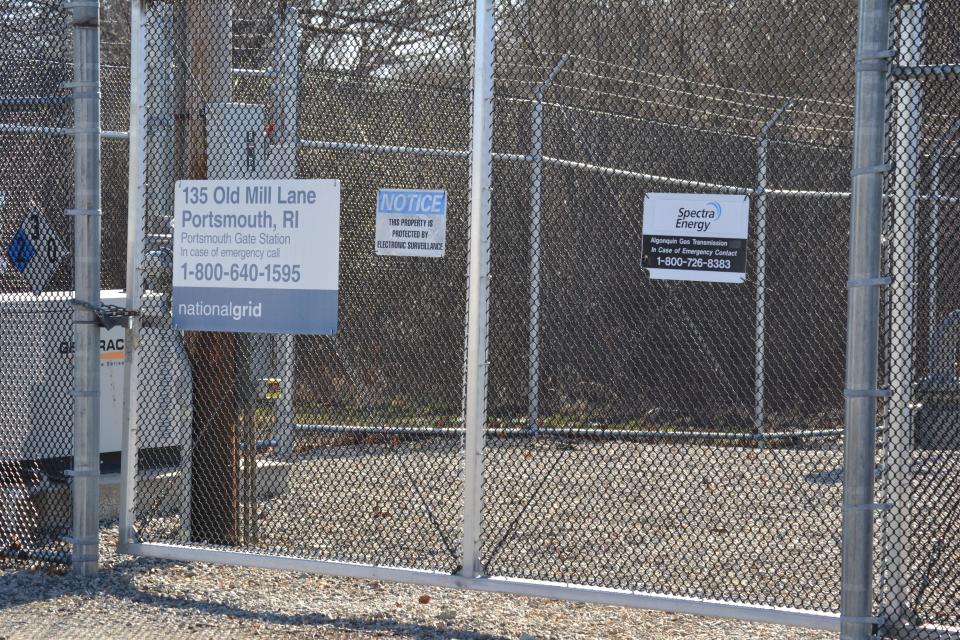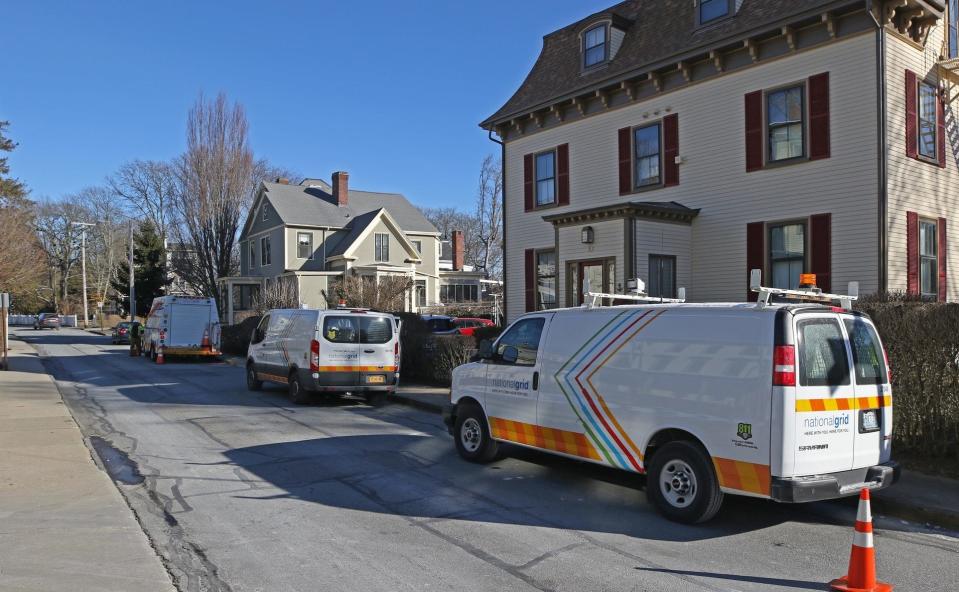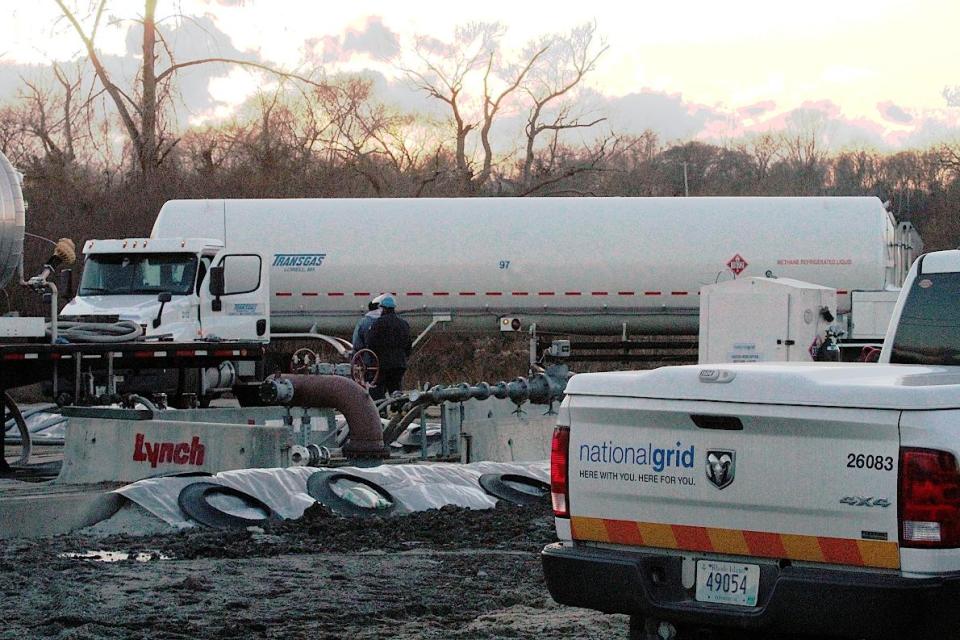'Neighborhood noise nightmare': Residents speak out against Portsmouth LNG facility plan
PORTSMOUTH – Stephen MacDonald called it the “neighborhood noise nightmare.” Nicole Ferrigno complained that “it’s lit up like a stadium” at night, its lights shining into her family’s bedrooms. Liz Drayton raised concerns about the safety of the surrounding homes.
They were among the half-dozen people who spoke Wednesday night against Rhode Island Energy’s proposal to make its temporary liquefied natural gas facility on the west side of Portsmouth a permanent part of an otherwise residential area.
“If you allow them to continue what they’re doing, it’s not for the betterment of the community,” Lawrence Silvia, who’s lived in the neighborhood for 82 years, told state regulators. “The facility doesn’t belong where it is.”

In 2019, after a natural gas outage on Aquidneck Island left thousands of residents without heat on some of the coldest days of winter, the state Energy Facility Siting Board approved the temporary facility on Old Mill Lane to back up the island’s gas system if a similar crisis occurred again.
Every winter since then, the board has allowed equipment to be trucked to the 5-acre site, along with stocks of LNG that could be vaporized and pumped into the gas distribution system as needed.
Rhode Island Energy argues that a permanent facility is necessary, not only as an emergency option in the event of another service interruption, but also to meet the needs of its 14,300 customers on the island when gas demand is at its highest.
But neighbors aren’t convinced it’s the best option. MacDonald, who lives across the street from the site, said he’s investing in electric heat pumps and is considering installing solar panels.
With state mandates in place to slash greenhouse gas emissions, this isn’t the time for Rhode Island’s largest energy utility to invest in more fossil fuel infrastructure, he said.
“Times are always changing,” MacDonald said. “The time for gas consumption is done.”
Application comes amid larger debate about future of natural gas
When the siting board approved the initial temporary waiver for the LNG facility, it had been only 10 months since the January outage that left about 7,500 customers in Newport and Middletown without heat for nearly a week.
State and federal investigations concluded that the service interruption was caused by an extraordinary set of circumstances – a malfunctioning valve on a transmission line in Massachusetts, a spike in demand caused by frigid weather and the failure of a liquefied natural gas plant in Providence to pump much-needed supplies into the system.
Board members said they felt they had no choice but to approve the waiver because there were no other alternatives to shore up the island’s gas system, which is supplied by a single pipeline that crosses beneath the Sakonnet River.

Afterward, regulators started considering long-term options to address a projected increase in heating demand on the island while also making the existing supply system more secure. While other alternatives were put on the table to make up for the shortfall in capacity, the utility determined the Old Mill Lane facility to be the preferred option.
The debate over the island’s gas system reflects larger questions being asked across the nation about the future of gas for heating amid efforts to eradicate the use of fossil fuels.
After Rhode Island's 2021 passage of the Act on Climate, which requires the state to reach net-zero emissions by 2050, the Public Utilities Commission opened a docket looking at ways to phase out the use of gas and ramp up the adoption of electric heating, among other alternatives. An advisory group is now working with consultants to parse the options. And in the shorter term, the commission is asking new questions about how much to invest in replacing gas pipes.
Environmental advocates say that Rhode Island Energy never adequately considered non-infrastructure solutions for Aquidneck Island. The Acadia Center wants the company to take a closer look at ramping up the use of heat pumps on the island and increasing investments in energy efficiency to tamp down usage. The Conservation Law Foundation says the company needs to better account for greenhouse gas emissions.
The office of Attorney General Peter Neronha has also weighed in on the climate implications.
“This docket presents a unique opportunity to consider a question of natural gas infrastructure investment in light of the Act on Climate and the state’s clear intention to pursue a cleaner energy portfolio while ensuring safe and reliable heat for customers,” the office wrote to the board.
More: With the future of natural gas in RI on the line, what to do with the aging infrastructure?
Rhode Island Energy proposes mitigating impacts on neighborhood
Under Rhode Island Energy’s application, the company would spend $15 million to build the Old Mill Lane facility and another $1.5 million a year to operate it.
It would be able to store up to 70,000 gallons of LNG on site, enough to supply the island for 37 hours continuously during an outage. If it were used only for peak-shaving on the days of highest demand, it could operate for six hours a day over three days without need for replenishment.

Jeffrey Montigny, an engineer with Rhode Island Energy, said the new plans would address some resident complaints. All equipment would be shifted south, away from the road and the homes there. The project would use new vaporizers that are quieter than the current one. The company is also considering erecting a sound wall that would stand up to 20 feet tall around the new vaporizers.
But while a wall would help with sound from the vaporizers, it would not address the louder venting sounds that come periodically when crews are refilling the LNG storage tanks. Those sounds are louder than what’s allowed under Portsmouth’s noise ordinance, and Rhode Island Energy’s application to the Town Council for a variance was rejected.
“We are looking into equipment that would muffle that noise,” Montigny said.
Despite the company’s efforts to make the facility less obtrusive, Councilman Keith Hamilton and others who spoke at the hearing said the company’s proposal is a bad idea.
“This is not a viable solution for the problems that we face on the island,” he said.
The siting board is set to begin evidentiary hearings on the application April 23. A decision is expected before next winter, said chairman Ron Gerwatowski.
“There are issues that have been raised that are legitimate ones that we need to think about,” he said.
This article originally appeared on The Providence Journal: RI Energy LNG facility in Portsmouth draws opposition from neighbors

